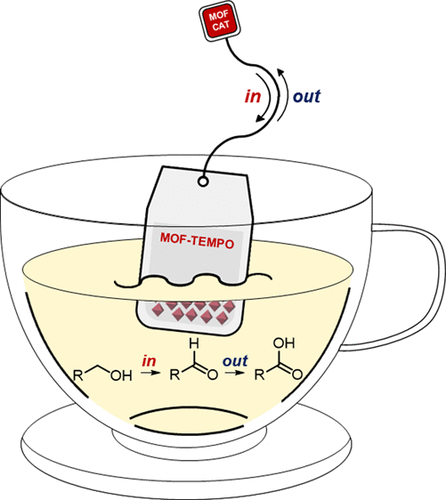当前位置:
X-MOL 学术
›
Inorg. Chem.
›
论文详情
Our official English website, www.x-mol.net, welcomes your
feedback! (Note: you will need to create a separate account there.)
Sequential Connection of Mutually Exclusive Catalytic Reactions by a Method Controlling the Presence of an MOF Catalyst: One-Pot Oxidation of Alcohols to Carboxylic Acids
Inorganic Chemistry ( IF 4.3 ) Pub Date : 2020-11-20 , DOI: 10.1021/acs.inorgchem.0c02809 Seongwoo Kim 1 , Ha-Eun Lee 1 , Jong-Min Suh 2 , Mi Hee Lim 2 , Min Kim 1
Inorganic Chemistry ( IF 4.3 ) Pub Date : 2020-11-20 , DOI: 10.1021/acs.inorgchem.0c02809 Seongwoo Kim 1 , Ha-Eun Lee 1 , Jong-Min Suh 2 , Mi Hee Lim 2 , Min Kim 1
Affiliation

|
A functionalized metal–organic framework (MOF) catalyst applied to the sequential one-pot oxidation of alcohols to carboxylic acids controls the presence of a heterogeneous catalyst. The conversion of alcohols to aldehydes was acquired through aerobic oxidation using a well-known amino-oxy radical-functionalized MOF. In the same flask, a simple filtration of the radical MOF with mild heating of the solution completely altered the reaction media, providing radical scavenger-free conditions suitable for the autoxidation of the aldehydes formed in the first step to carboxylic acids. The mutually exclusive radical-catalyzed aerobic oxidation (the first step with MOF) and radical-inhibited autoxidation (the second step without MOF) are sequentially achieved in a one-pot manner. Overall, we demonstrate a powerful and efficient method for the sequential oxidation of alcohols to carboxylic acids by employing a readily functionalizable heterogeneous MOF. In addition, our MOF in-and-out method can be utilized in an environmentally friendly way for the oxidation of alcohols to carboxylic acids of industrial and economic value with broad functional group tolerance, including 2,5-furandicarboxylic acid and 1,4-benzenedicarboxylic acid, with good yield and reusability. Furthermore, MOF-TEMPO, as an antioxidative stabilizer, prevents the undesired oxidation of aldehydes, and the perfect “recoverability” of such a reactive MOF requires a re-evaluation of the advantages of MOFs from heterogeneity in catalytic and related applications.
中文翻译:

相互排斥的催化反应的顺序连接,通过控制MOF催化剂的存在的方法:醇一锅氧化成羧酸
一种功能化的金属-有机骨架(MOF)催化剂,用于将醇依次单锅氧化为羧酸,可控制非均相催化剂的存在。使用众所周知的氨基-氧自由基官能化的MOF通过需氧氧化将醇转化为醛。在同一烧瓶中,通过温和加热溶液对自由基MOF进行简单过滤,完全改变了反应介质,从而提供了无自由基清除剂的条件,适合于第一步中形成的醛自氧化为羧酸。相互排斥的自由基催化的好氧氧化(带有MOF的第一步)和自由基抑制的自氧化(不带有MOF的第二步)依次实现。总体,我们展示了一种通过使用易于官能化的异质MOF将醇类依次氧化为羧酸的有效方法。此外,我们的MOF进出方法可以以环境友好的方式用于将醇氧化为具有广泛的官能团耐受性的工业和经济价值的羧酸,包括2,5-呋喃二甲酸和1,4-苯二甲酸,具有良好的收率和可重复使用性。此外,MOF-TEMPO作为一种抗氧化稳定剂,可防止醛类发生不希望的氧化,而这种反应性MOF的完美“可回收性”需要从催化和相关应用中的异质性重新评估MOF的优势。此外,我们的MOF进出方法可以以环境友好的方式用于将醇氧化为具有广泛的官能团耐受性的工业和经济价值的羧酸,包括2,5-呋喃二甲酸和1,4-苯二甲酸,具有良好的收率和可重复使用性。此外,MOF-TEMPO作为一种抗氧化稳定剂,可防止醛类发生不希望的氧化,而这种反应性MOF的完美“可回收性”需要从催化和相关应用中的异质性重新评估MOF的优势。此外,我们的MOF进出方法可以以环境友好的方式用于将醇氧化为具有广泛的官能团耐受性的工业和经济价值的羧酸,包括2,5-呋喃二甲酸和1,4-苯二甲酸,具有良好的收率和可重复使用性。此外,MOF-TEMPO作为一种抗氧化稳定剂,可防止醛类发生不希望的氧化,而这种反应性MOF的完美“可回收性”需要从催化和相关应用中的异质性重新评估MOF的优势。具有良好的产量和可重复使用性。此外,MOF-TEMPO作为一种抗氧化稳定剂,可防止醛类发生不希望的氧化,而这种反应性MOF的完美“可回收性”需要从催化和相关应用中的异质性重新评估MOF的优势。具有良好的产量和可重复使用性。此外,MOF-TEMPO作为一种抗氧化稳定剂,可防止醛类发生不希望的氧化,而这种反应性MOF的完美“可回收性”需要从催化和相关应用中的异质性重新评估MOF的优势。
更新日期:2020-12-07
中文翻译:

相互排斥的催化反应的顺序连接,通过控制MOF催化剂的存在的方法:醇一锅氧化成羧酸
一种功能化的金属-有机骨架(MOF)催化剂,用于将醇依次单锅氧化为羧酸,可控制非均相催化剂的存在。使用众所周知的氨基-氧自由基官能化的MOF通过需氧氧化将醇转化为醛。在同一烧瓶中,通过温和加热溶液对自由基MOF进行简单过滤,完全改变了反应介质,从而提供了无自由基清除剂的条件,适合于第一步中形成的醛自氧化为羧酸。相互排斥的自由基催化的好氧氧化(带有MOF的第一步)和自由基抑制的自氧化(不带有MOF的第二步)依次实现。总体,我们展示了一种通过使用易于官能化的异质MOF将醇类依次氧化为羧酸的有效方法。此外,我们的MOF进出方法可以以环境友好的方式用于将醇氧化为具有广泛的官能团耐受性的工业和经济价值的羧酸,包括2,5-呋喃二甲酸和1,4-苯二甲酸,具有良好的收率和可重复使用性。此外,MOF-TEMPO作为一种抗氧化稳定剂,可防止醛类发生不希望的氧化,而这种反应性MOF的完美“可回收性”需要从催化和相关应用中的异质性重新评估MOF的优势。此外,我们的MOF进出方法可以以环境友好的方式用于将醇氧化为具有广泛的官能团耐受性的工业和经济价值的羧酸,包括2,5-呋喃二甲酸和1,4-苯二甲酸,具有良好的收率和可重复使用性。此外,MOF-TEMPO作为一种抗氧化稳定剂,可防止醛类发生不希望的氧化,而这种反应性MOF的完美“可回收性”需要从催化和相关应用中的异质性重新评估MOF的优势。此外,我们的MOF进出方法可以以环境友好的方式用于将醇氧化为具有广泛的官能团耐受性的工业和经济价值的羧酸,包括2,5-呋喃二甲酸和1,4-苯二甲酸,具有良好的收率和可重复使用性。此外,MOF-TEMPO作为一种抗氧化稳定剂,可防止醛类发生不希望的氧化,而这种反应性MOF的完美“可回收性”需要从催化和相关应用中的异质性重新评估MOF的优势。具有良好的产量和可重复使用性。此外,MOF-TEMPO作为一种抗氧化稳定剂,可防止醛类发生不希望的氧化,而这种反应性MOF的完美“可回收性”需要从催化和相关应用中的异质性重新评估MOF的优势。具有良好的产量和可重复使用性。此外,MOF-TEMPO作为一种抗氧化稳定剂,可防止醛类发生不希望的氧化,而这种反应性MOF的完美“可回收性”需要从催化和相关应用中的异质性重新评估MOF的优势。











































 京公网安备 11010802027423号
京公网安备 11010802027423号